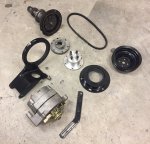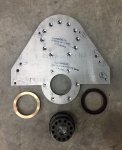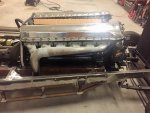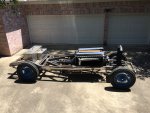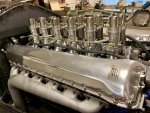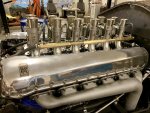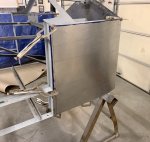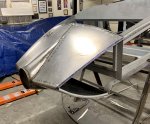We just spent fun times with Chip, Peggy, and Charley over Thanksgiving. One of the days, they visited our house so that Chip could see my latest build project. Chip has now badgered me sufficiently and talked me into starting this thread that shows the build history of my Roll Royce Merlin-powered car. These engines were designed in the 30s but are absolute works of art by even today's standards; V-12, 27 litres (1656 cu.in), all-alloy construction, overhead cams, 4 valves per cylinder, twin plugs per cylinder. There were many variants produced and they powered the Spitfires, Hurricanes, P-38s, P-51 and many other awesome planes, plus tanks and motor torpedo boats. Thousands and thousands were built but after the war, many were scrapped for their alloy. I found mine in the Australian outback and had it shipped to Texas in 2016 (coincidentally by the same company that later shipped our GTs to Europe for Le Mans.
Rather than adapting an existing chassis as folk like Jay Leno have done, I opted to go for construction from scratch: I bought a bunch of 6"x2" and 4"x2" tubing and had it bent to my specifications. I welded it up to form the basic frame. The pictures should be self-explanatory. The front end is a 1947 Ford F1 truck beam axle withF-250 springs. Rear suspension is early-Mustang leaf springs with extra leaves. The friction shocks are brand-new Andre Hartford units, identical to those used back in the 20s - crazy that you can call them up and order a set of shock absorbers from over 90 years ago! The rear end was a challenge because the engine red-lines at 2650RPM and I couldn't find an axle with a low-enough ratio to give a decent top speed. Eventually I went with an LSR quick-change rear end with 2.2:1 straight-cut quick-change gears. A 60's Chevy steering box turns the wheels (no power steering) and the chassis is rounded-out by Corvette boosted master cylinder, 40 gallon fuel tank and 10 gallon oil tank. I had the 21" wheels custom-built in the UK and the tyres are 35" diameter by 7" wide, rated (amazingly enough) for speeds up to 135mph.
Making this engine work in a vehicle meant dumping the 24V front-mounted starter so I could fit an accessory belt with alternator - machined adaptors did the trick. At the other end of the engine I made a 1" billet adaptor plate that allows a built C-6 to mate up, along with flex plate and big block Ford starter motor (yes, it has the balls to crank the motor no problem). The combined trans/engine unit sits on a subframe that's isolate from the chassis by poly bushings. This lets the frame flex without throwing stresses into the engine. Amazingly enough, everything fitted perfectly! I had a local engine builder machine a billet intake manifold to take six weber 48-IDA carbs. I'm still screwing with their jetting and setting, although I got a lot of help from Jay Leno's Big Dog garage with this. I fabricated the exhaust manifolds and system, including adding cut-outs so I can let the neighbours know I'm around when I feel like it! I reckon the engine is putting out around 850 hp and 1650 ft-lbs torque.
I got to drive the running chassis a couple of months ago (can't figure out how to embed a big video of this) and everything worked perfectly. The only issue I had was that the new starter wouldn't spin the engine fast enough for the magnetos to kick-in, so eventually I fitted a crank trigger, coil packs and twin ECUs which made the thing start instantly. I made all the wiring harnesses myself using old-school fittings, and the dash is engine-turned stainless with Classic instruments and vintage switches.
The current effort is the body. A couple of months ago I took classes in California to learn the English Wheel and other body tools. I made up a 'skeleton' of 3/4" tubing formed over a series of plywood formers, and am now well into wheeling up the panels. The body is roughly based on a 1928 Rolls Phantom 16EX that was in the Simeone museum last time I checked. Bodywork is going much faster than anticipated, and I hope to be 100% finished and driving before the end of 2020. I'll post updates of progress as I make it.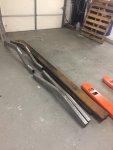
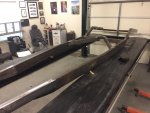
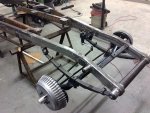

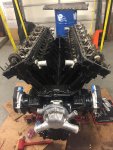
Rather than adapting an existing chassis as folk like Jay Leno have done, I opted to go for construction from scratch: I bought a bunch of 6"x2" and 4"x2" tubing and had it bent to my specifications. I welded it up to form the basic frame. The pictures should be self-explanatory. The front end is a 1947 Ford F1 truck beam axle withF-250 springs. Rear suspension is early-Mustang leaf springs with extra leaves. The friction shocks are brand-new Andre Hartford units, identical to those used back in the 20s - crazy that you can call them up and order a set of shock absorbers from over 90 years ago! The rear end was a challenge because the engine red-lines at 2650RPM and I couldn't find an axle with a low-enough ratio to give a decent top speed. Eventually I went with an LSR quick-change rear end with 2.2:1 straight-cut quick-change gears. A 60's Chevy steering box turns the wheels (no power steering) and the chassis is rounded-out by Corvette boosted master cylinder, 40 gallon fuel tank and 10 gallon oil tank. I had the 21" wheels custom-built in the UK and the tyres are 35" diameter by 7" wide, rated (amazingly enough) for speeds up to 135mph.
Making this engine work in a vehicle meant dumping the 24V front-mounted starter so I could fit an accessory belt with alternator - machined adaptors did the trick. At the other end of the engine I made a 1" billet adaptor plate that allows a built C-6 to mate up, along with flex plate and big block Ford starter motor (yes, it has the balls to crank the motor no problem). The combined trans/engine unit sits on a subframe that's isolate from the chassis by poly bushings. This lets the frame flex without throwing stresses into the engine. Amazingly enough, everything fitted perfectly! I had a local engine builder machine a billet intake manifold to take six weber 48-IDA carbs. I'm still screwing with their jetting and setting, although I got a lot of help from Jay Leno's Big Dog garage with this. I fabricated the exhaust manifolds and system, including adding cut-outs so I can let the neighbours know I'm around when I feel like it! I reckon the engine is putting out around 850 hp and 1650 ft-lbs torque.
I got to drive the running chassis a couple of months ago (can't figure out how to embed a big video of this) and everything worked perfectly. The only issue I had was that the new starter wouldn't spin the engine fast enough for the magnetos to kick-in, so eventually I fitted a crank trigger, coil packs and twin ECUs which made the thing start instantly. I made all the wiring harnesses myself using old-school fittings, and the dash is engine-turned stainless with Classic instruments and vintage switches.
The current effort is the body. A couple of months ago I took classes in California to learn the English Wheel and other body tools. I made up a 'skeleton' of 3/4" tubing formed over a series of plywood formers, and am now well into wheeling up the panels. The body is roughly based on a 1928 Rolls Phantom 16EX that was in the Simeone museum last time I checked. Bodywork is going much faster than anticipated, and I hope to be 100% finished and driving before the end of 2020. I'll post updates of progress as I make it.







